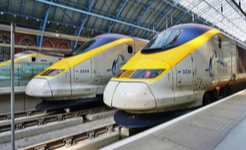Channel Tunnel at 25: an unprecedented engineering project
The first passenger journey through the Channel Tunnel took place 25 years ago today. The long-running project was finally completed in 1994. It was the product of almost two centuries of on and off planning and achieved something that people weren’t sure could even be done.

While the project went over budget, eventually costing US$14.9bn (£11.6bn), it more than realised its benefits. Since the first journey 25 years ago, 185 million people have travelled through the Tunnel, and €135bn worth of goods have been traded between the two nations. It is considered one of the seven wonders of the modern world.
The London-Paris route also emits 90 per cent less greenhouse gas emissions than the equivalent flight, according to Eurostar, so it has unwittingly contributed to the carbon reduction agenda over the past 25 years. And to mark the 25th anniversary of the first passenger train, Eurostar has pledged to plant trees for every train and offer plastic free services as part of new environmental commitments.
A private project
One of the biggest hurdles to get any kind of Channel linking project underway, apart from the logistics involved, was the budget. Neither the British nor French governments could afford to fund the project, despite the economic boost it would inevitably provide.
To get around this, the two governments opened it up to private sector proposals. Each submitting company had a set of requirements to meet within their proposals: it had to provide a plan to raise the funds to build the project, a plan to operate the link once building work was completed, and a spec that gave the finished link a life span of at least 120 years.
Ten proposals were submitted – not all of them tunnels. Six were dismissed, primarily for being too outlandish and impractical. The final four on the shortlist were:
- Channel Tunnel: a rail proposal based on a previous 1975 scheme presented by Channel Tunnel Group (CTG)/France Manche (FM).
- Eurobridge: a 4.5 km span suspension bridge with a roadway in an enclosed tube proposed by Laing, Brown and Root, ICI.
- Euroroute: a 21 km tunnel between artificial islands connected by bridges, presented by an Anglo-French consortium.
- Channel Expressway: large diameter road tunnels with mid-channel ventilation towers, proposed by British Ferries.
Channel Tunnel was picked as the winning project, and CTG and FM became the Eurotunnel Group. The proposal was to create a 51.5km double rail tunnel, with an additional service tunnel. No funding was to come from either government, as a way to mitigate financial risk – it was to be entirely privately funded. The project was funded by several investors, including more than 200 banks.
Construction ingenuity
The construction of the Tunnel was split between consortiums of five companies on either side of the Channel: Balfour Beatty, Costain, Tarmac, Taylor Woodrow and Wimpey on the British side, and Bouygues, Dumez, Société Auxiliaire d'Entreprises, Société générale d'Entreprises and Spie Batignolles on the French. These worked together in the joint venture companies Translink Joint Venture and GIE Transmanche Construction respectively. These partnerships were then brought together under TransManche Link, a bi-national project organisation.
Risks involved in the project included technological risks, associated with the costs and effectiveness of the technology needed to create the tunnel; credit risk, based on the reliance on outside investors; and bid risk, which ultimately proved no problem as contracts on the project were so lucrative.
Building the tunnel involved 13,000 engineers, technicians and workers and 11 specially made boring machines working at either side of the Channel. Geological studies were conducted to determine where best to start construction – the lower chalk layer in the sea bed was determined to be the best to dig through. Construction finally began in earnest in 1986.
One of the biggest challenges in the initial stages was ensuring that the two construction projects actually met in the middle. State of the art, laser-based surveying equipment was used, but on such a large project, there was no guarantee that it would work. The first tunnel was completed in December 1990, removing that risk from the project.
It was a historic moment of human achievement in civil engineering – the moment that confirmed the Channel Tunnel would be completed. Even now, 25 years later, the achievements of the Channel Tunnel project team is incredibly impressive.
Further reading
- Assessing the risk of a cross-Channel swim
- Beyond the Job Project: How I Plan To Swim The English Channel (🔒)

0 comments
Log in to post a comment, or create an account if you don't have one already.